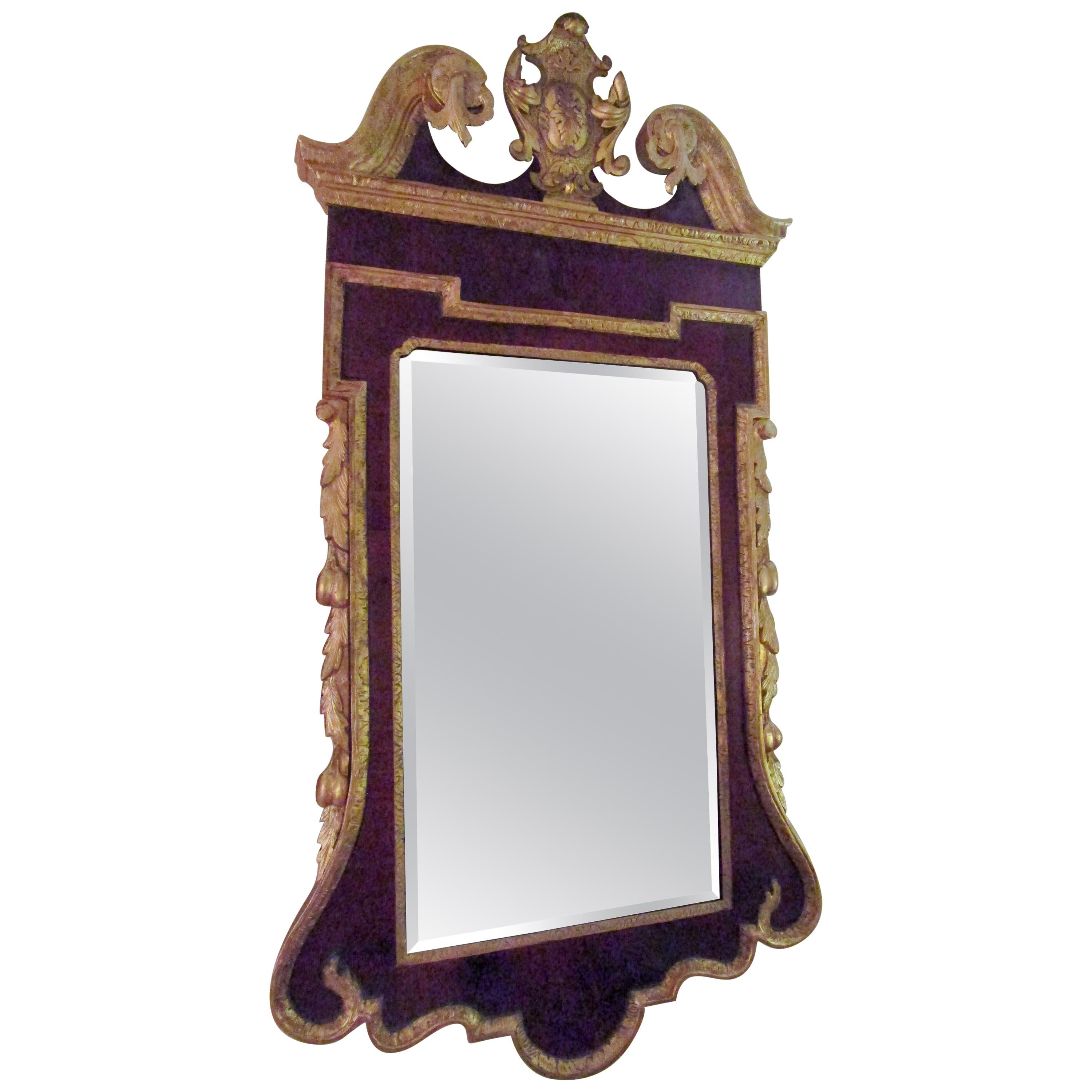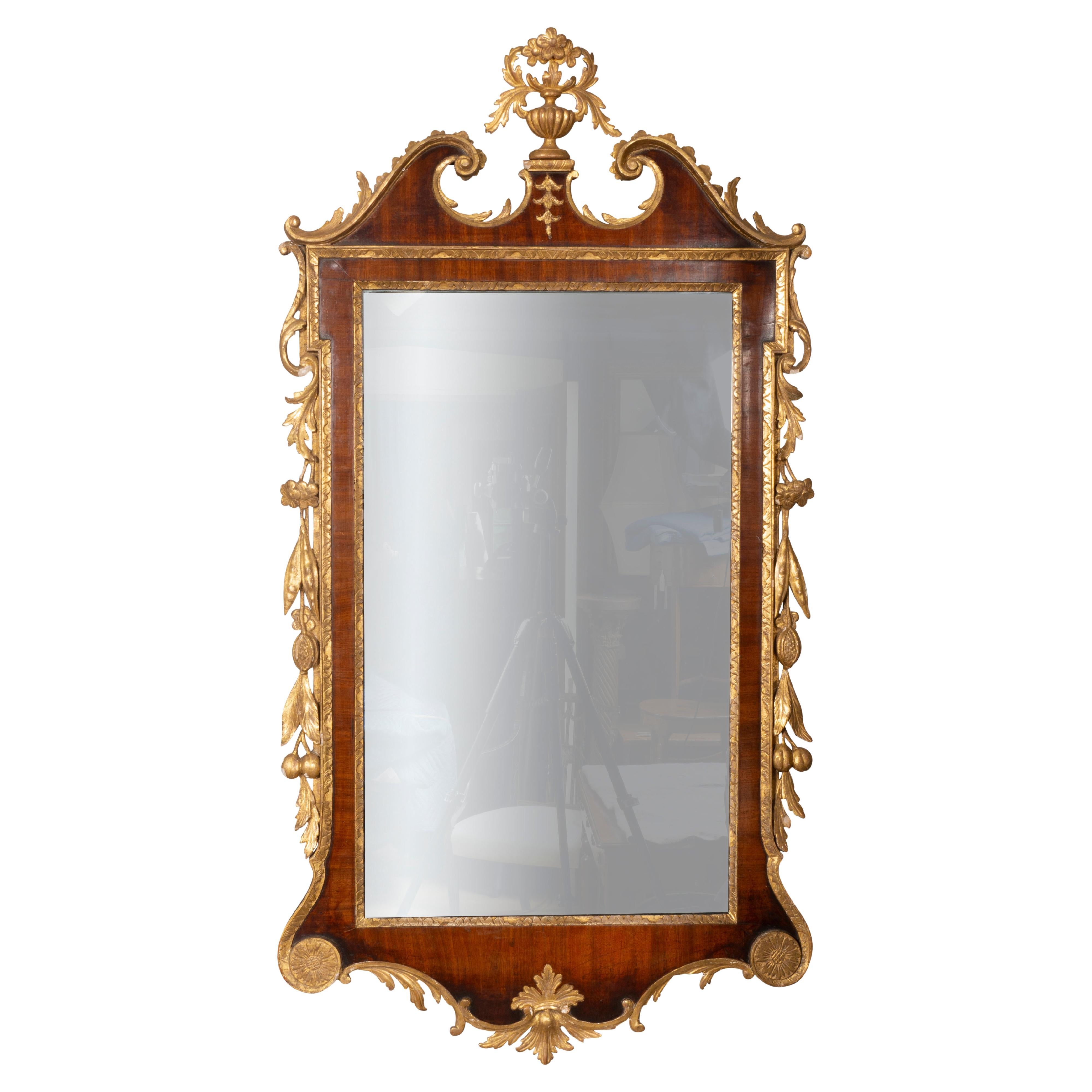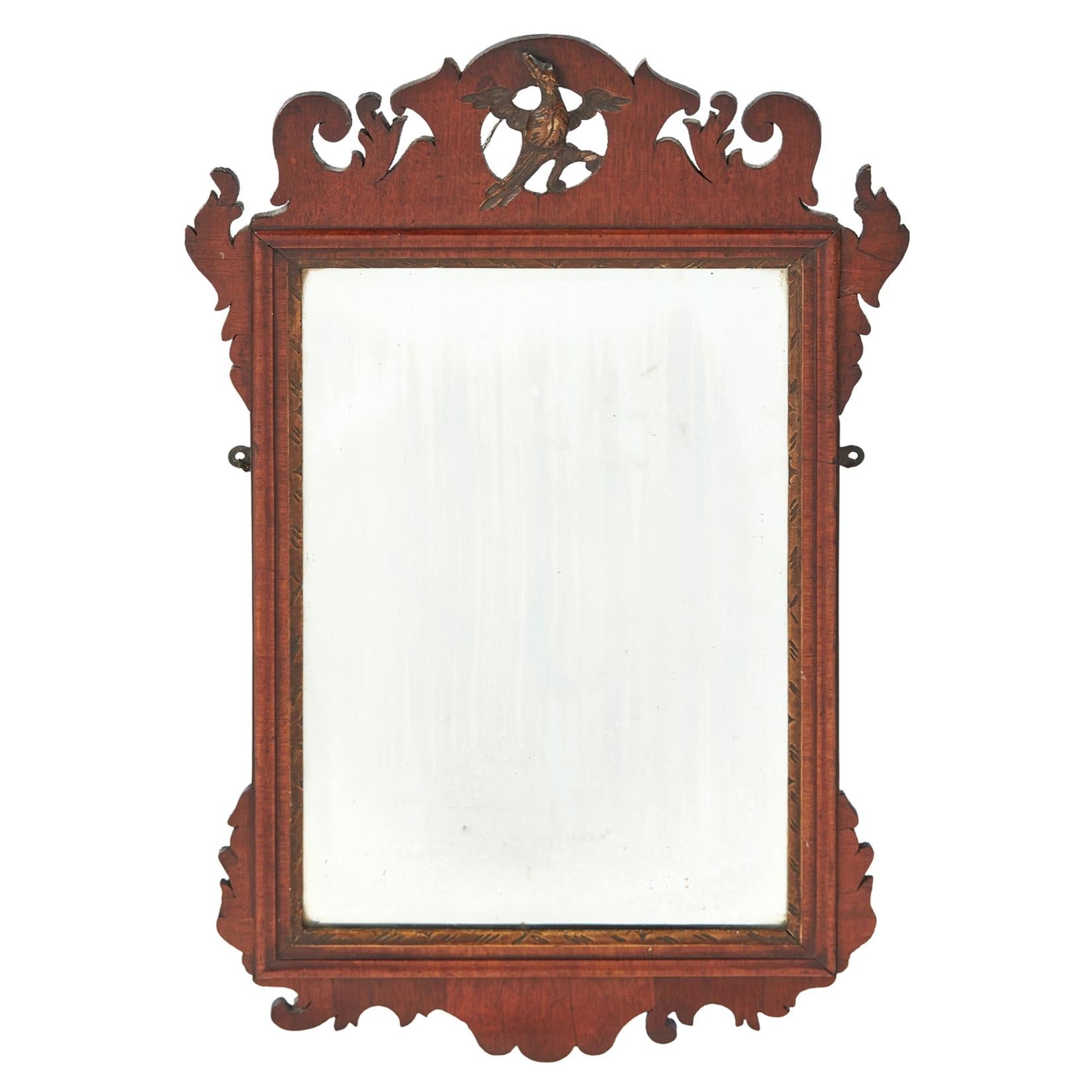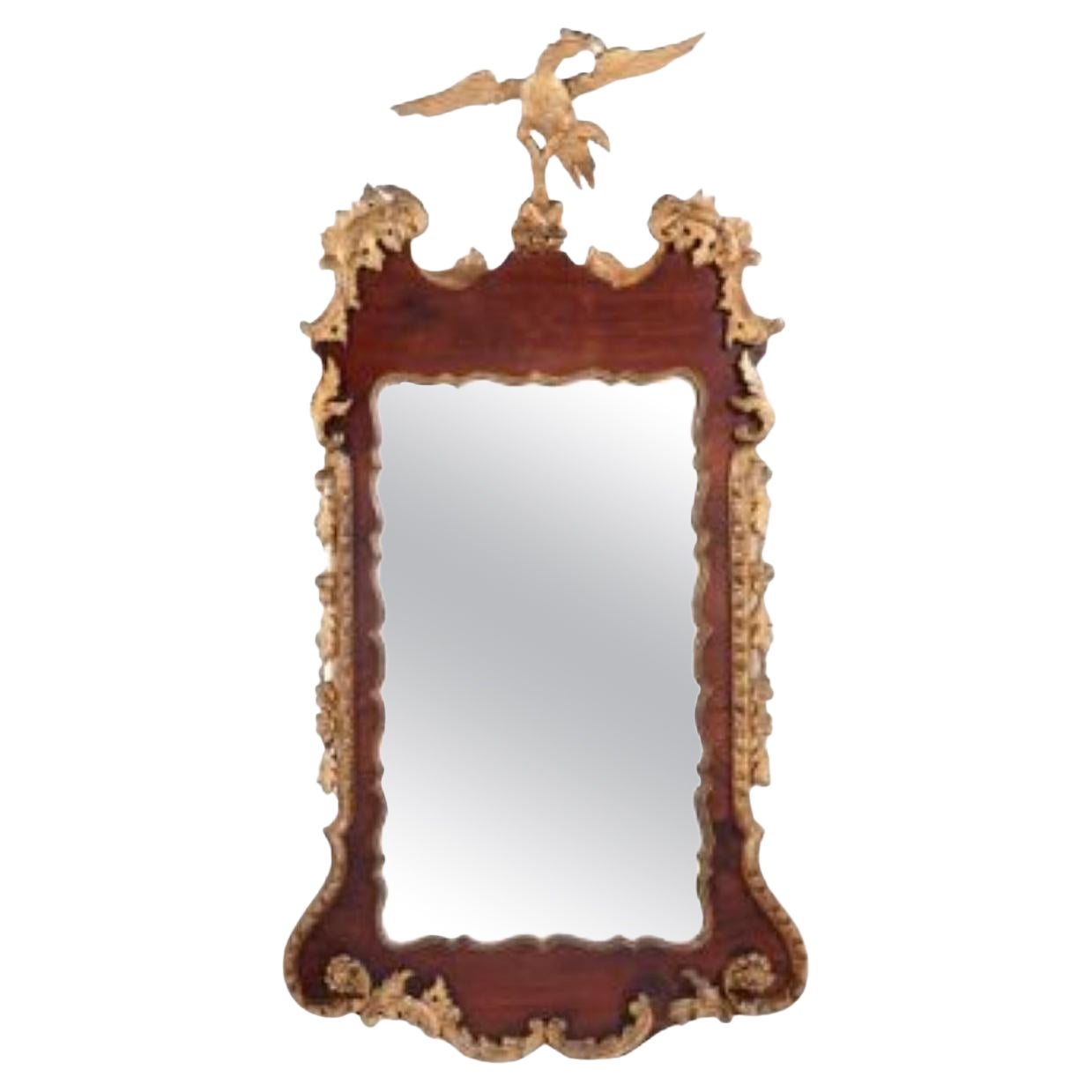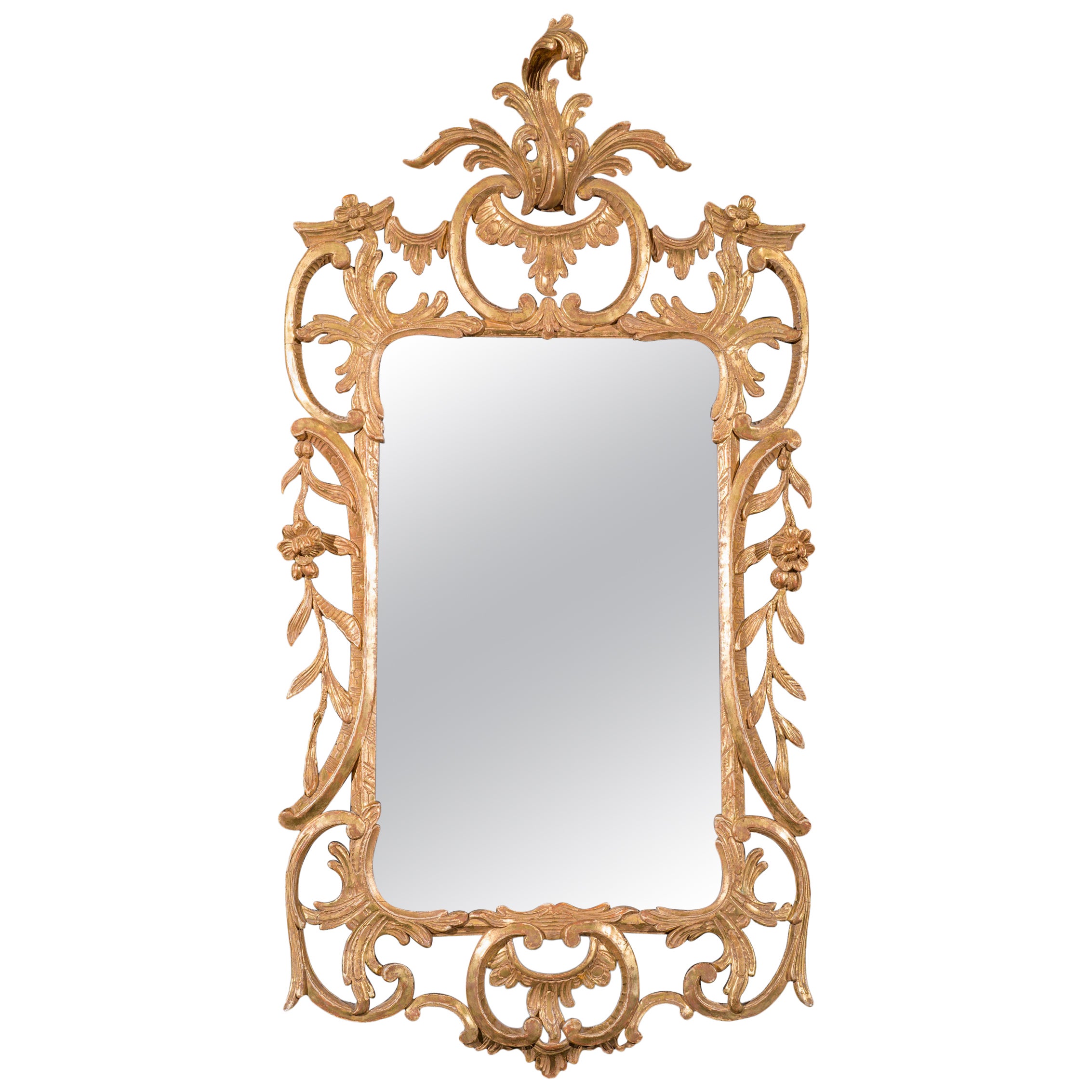Items Similar to Antique George III Mahogany Parcel Gilt Wall Mirror 18th C 94 x 51 cm
Want more images or videos?
Request additional images or videos from the seller
1 of 7
Antique George III Mahogany Parcel Gilt Wall Mirror 18th C 94 x 51 cm
About the Item
This is a beautiful antique George III mahogany parcel gilt wall mirror, circa 1780 in date.
The mirror has got a beautiful mahogany frame with carved scrolling surmounted by a pierced gilt foliate motif with bevelled plate below.
It is a beautiful mirror which would look good wherever placed.
THE BOTANICAL NAME FOR THE MAHOGANY THIS ITEM IS MADE OF IS SWIETENIA MACROPHYLLA AND THIS TYPE OF MAHOGANY IS NOT SUBJECT TO CITES REGULATION.
Condition:
In excellent condition.
The glass of the mirror shows signs of age, which add to the character, the frame is in excellent condition.
Dimensions in cm:
Height 94 cm x Width 51 cm x Depth 3 cm
Dimensions in inches:
Height 3 feet, 1 inch x Width 1 foot, 8 inches x Depth 1 inch
Mirrors
are commonly used for personal grooming or admiring oneself (in which case the archaic term looking-glass is sometimes still used), decoration, and architecture.
The earliest manufactured mirrors were pieces of polished stone such as obsidian, a naturally occurring volcanic glass. In classical antiquity, mirrors were made of solid metal (bronze, later silver) and were too expensive for widespread use by common people; they were also prone to corrosion. Due to the low reflectivity of polished metal, these mirrors also gave a darker image than modern ones, making them unsuitable for indoor use with the artificial lighting of the time.
The method of making mirrors out of plate glass was invented by 16th-century Venetian glassmakers on the island of Murano, who covered the back of the glass with mercury, obtaining near-perfect and undistorted reflection. For over one hundred years, Venetian mirrors installed in richly decorated frames served as luxury decorations for palaces throughout Europe, but the secret of the mercury process eventually arrived in London and Paris during the 17th century, due to industrial espionage. French workshops succeeded in large scale industrialization of the process, eventually making mirrors affordable to the masses.
Our reference: 04572
- Dimensions:Height: 37.01 in (94 cm)Width: 20.08 in (51 cm)Depth: 1.19 in (3 cm)
- Style:George III (Of the Period)
- Materials and Techniques:
- Place of Origin:
- Period:1780-1789
- Date of Manufacture:circa 1780
- Condition:
- Seller Location:London, GB
- Reference Number:
About the Seller
5.0
Platinum Seller
These expertly vetted sellers are 1stDibs' most experienced sellers and are rated highest by our customers.
Established in 1983
1stDibs seller since 2012
1,204 sales on 1stDibs
Typical response time: 1 hour
Associations
LAPADA - The Association of Arts & Antiques Dealers
- ShippingRetrieving quote...Ships From: London, United Kingdom
- Return PolicyA return for this item may be initiated within 14 days of delivery.
More From This SellerView All
- Antique Large French Giltwood Wall Mirror 18th Century - 171x101cmLocated in London, GBThis is a large impressive antique French Louis XIV carved giltwood and gesso wall mirror, Circa 1760 in date. The frame is surmounted with an elaborate carved and pierced giltwood ...Category
Antique 1760s French Louis XIV Wall Mirrors
MaterialsGiltwood
- Antique George III Inlaid Flame Mahogany Sideboard, 18th CenturyLocated in London, GBThis is a superb antique George III inlaid flame mahogany bowfront sideboard, circa 1780 in date. The top is banded in satinwood and...Category
Antique 1780s English George III Sideboards
MaterialsMahogany
- Antique George III Scottish Mahogany Bowfront Sideboard 18th CenturyLocated in London, GBThis is a fine antique Scottish flame mahogany and line inlaid bowfront sideboard made in the reign of George III, circa 1790 in date. The splendid piece features a central frieze ...Category
Antique 1790s Scottish George III Sideboards
MaterialsMahogany
- Antique George III Flame Mahogany Serpentine Sideboard, 18th CenturyLocated in London, GBThis is a superb antique George III inlaid flame mahogany serpentine sideboard, circa 1790 in date. With wood banding and marquetry spandrels, the central frieze drawer flanked by deep drawers, the right side drawer with divisions for bottles. The drawers fitted with the original and beautiful ormolu lion's head ring handles. It is raised on elegant square tapering legs on spade feet and is complete with working locks and key. Add an elegant touch to a special place in your home with this superb antique serpentine shaped sideboard. The botanical name for the mahogany this item is made of is Swietenia macrophylla and this type of mahogany is not subject to CITES regulation. Provenance: Major Edward Croft-Murray, Perivale, Ryde, Isle of Wight. From the collection of Edward Croft-Murray CBE (1907-1980). Condition: In excellent condition having been beautifully cleaned, polished and waxed in our workshops, please see photos for confirmation. Dimensions in cm: Height 93 x Width 183 x Depth 74 Dimensions in inches: Height 3 feet, 1 inch x Width 6 foot x Depth 2 foot, 5 inches Flame Mahogany Thomas Sheraton - 18th century Furniture designer, once characterized mahogany as "best suited to furniture where strength is demanded as well as a wood that works...Category
Antique 1790s English George III Sideboards
MaterialsMahogany
- Antique George III Mahogany Library Writing Table Desk, 18th CenturyLocated in London, GBThis is a fine antique George III mahogany and marquetry library table, circa 1780 in date. The table features beautiful floral and scrolling foliate marquetry throughout, with flame mahogany marquetry panels and gonçalo alves crossbanding. The rectangular top is fitted with the original emerald green gold tooled inset leather writing surface above a pair of crossbanded frieze drawers, raised on square tapered legs. It is freestanding, finished on all sides, so that it can stand freely in the middle of a room, making it extremely suitable for a large home or office. Complete with original brass handles, working locks and keys. THE BOTANICAL NAME FOR THE MAHOGANY THIS ITEM IS MADE OF IS SWIETENIA MACROPHYLLA AND THIS TYPE OF MAHOGANY IS NOT SUBJECT TO CITES REGULATION. Condition: In excellent condition having been beautifully cleaned, polished and waxed in our workshops, and only shows minor signs of wear commensurate with age and use. Please see photos for confirmation. Dimensions in cm: Height 76 x width 144 x depth 84 Dimensions in inches: Height 29.9 x width 56.7 x depth 33.1 Marquetry is decorative artistry where pieces of material (such as wood, pewter or brass silver) of different colours are inserted into surface wood veneer to form intricate patterns such as scrolls or flowers. The technique of veneered marquetry had its inspiration in 16th century Florence. Marquetry elaborated upon Florentine techniques of inlaying solid marble slabs with designs formed of fitted marbles, jaspers and semi-precious stones. This work, called opere di commessi, has medieval parallels in Central Italian "Cosmati"-work of inlaid marble floors, altars and columns. The technique is known in English as pietra dura, for the "hardstones" used: onyx, jasper, cornelian, lapis lazuli and colored marbles. In Florence, the Chapel of the Medici at San Lorenzo is completely covered in a colored marble facing using this demanding jig-sawn technique. Techniques of wood marquetry were developed in Antwerp and other Flemish centers of luxury cabinet-making during the early 16th century. The craft was imported full-blown to France after the mid-seventeenth century, to create furniture of unprecedented luxury being made at the royal manufactory of the Gobelins, charged with providing furnishings to decorate Versailles and the other royal residences of Louis XIV. Early masters of French marquetry were the Fleming Pierre Golle and his son-in-law, André-Charles Boulle, who founded a dynasty of royal and Parisian cabinet-makers (ébénistes) and gave his name to a technique of marquetry employing brass with pewter in arabesque or intricately foliate designs. Flame mahogany Thomas Sheraton - 18th century furniture designer, once characterized mahogany as "best suited to furniture where strength is demanded as well as a wood that works...Category
Antique 1780s English George III Desks and Writing Tables
MaterialsLeather, Mahogany
- Antique George III Serpentine Flame Mahogany Chest Drawers, 18th CenturyLocated in London, GBThis is beautifully crafted antique George III flame mahogany serpentine fronted chest of drawers, circa 1780 in date. The curvaceous serpentine chest is made from the finest quality flame mahogany. The top features a moulded edge, it has four long graduated drawers above a shaped apron and it is raised on splayed bracket feet. Fitted with decorative brass handles and with working locks and key. This piece is truly unique and is guaranteed to bring beauty and charm to your home for many years to come. THE BOTANICAL NAME FOR THE MAHOGANY THIS ITEM IS MADE OF IS SWIETENIA MACROPHYLLA AND THIS TYPE OF MAHOGANY IS NOT SUBJECT TO CITES REGULATION. Condition: In excellent condition having been beautifully cleaned, polished and waxed in our workshops, please see photos for confirmation. Dimensions in cm: Height 98 x width 117 x depth 62 Dimensions in inches: Height 38.6 x width 46.1 x depth 24.4 Flame Mahogany Thomas Sheraton - 18th century Furniture designer, once characterized mahogany as "best suited to furniture where strength is demanded as well as a wood that works...Category
Antique 1780s English George III Commodes and Chests of Drawers
MaterialsBrass
You May Also Like
- 18th Century George III Parcel-Gilt Mahogany MirrorLocated in Savannah, GAThis elegant George III parcel-gilt mirror of beautifully grained Honduras mahogany features a scrolled swan neck pediment with central cartouche and elaborate foliate carving. More ...Category
Antique 1720s English George III Wall Mirrors
MaterialsMirror, Mahogany, Giltwood
- George III Parcel-Gilt Mahogany MirrorLocated in Woodbury, CTThis handsome mirror most likely would have graced the home of someone of high social and economic standing as it has Fine Rococo carving and a large piece of highly valued (and orig...Category
Antique 19th Century British George III Wall Mirrors
MaterialsMahogany, Giltwood
- Fine George III Mahogany and Parcel Gilt MirrorLocated in Essex, MAWith vase and floral finial and broken arch pediment over a mirror plate flanked by gilt carving of leaves, flowers and nuts. The bottom with gilded roundels and carved scrolled deco...Category
Antique 1770s English George III Wall Mirrors
MaterialsMahogany, Giltwood
- Antique George III Mahogany Wall MirrorLocated in Suffolk, GBGeorge III mahogany wall mirror complete with its gilded ho ho bird and original plate mirror, surrounded by fretted scrolls. Lovely original ...Category
Antique Early 19th Century English George III Wall Mirrors
MaterialsMirror, Mahogany
- A George II Mahogany & Parcel Gilt Mirror, mid 18th CenturyLocated in Lincoln, GBA GEORGE II MAHOGANY AND PARCEL GILT MIRRORMID 18TH CENTURY. The rectangular plate in a shaped frame surmounted by an eagle cresting, with foliate drops, shaped apron133cm high, 72cm...Category
Antique 18th Century Wall Mirrors
MaterialsMahogany
- 18th Century George II Parcel-Gilt Walnut MirrorLocated in Nashville, TNHere is a handsome scroll-cut parcel-gilt Walnut mirror from the middle of the 18th century in the George II style. The frame is solid walnut, the glass is original as well is the back.Category
Antique Mid-18th Century American George II Wall Mirrors
MaterialsWalnut
